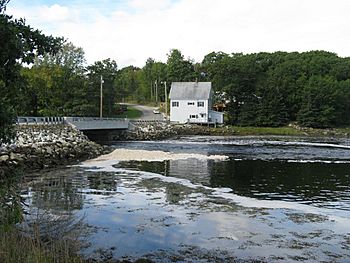Bagaduce River facts for kids
Quick facts for kids Bagaduce River |
|
|---|---|

ME Route 175/176 crosses the Bagaduce River
|
|
| Country | United States |
| Physical characteristics | |
| Main source | Maine |
| River mouth | Penobscot Bay sea level 44°22′37″N 68°48′50″W / 44.377°N 68.814°W |
| Length | 14 miles (23 km) |
The Bagaduce River is a special kind of river in Hancock County, Maine. It's a tidal river, which means its water levels change a lot with the ocean's tides. This river flows into Penobscot Bay near the town of Castine.
Contents
Discover the Bagaduce River
The Bagaduce River is an important waterway in coastal Maine. It stretches for about 14 miles (23 km) (22.5 km). The river begins where Black Brook and the outflow of Walker Pond meet. From there, it flows north, northwest, and then southwest.
Where is the Bagaduce River Located?
This river forms a natural border between several towns. On its left bank is Brooksville. On its right bank are Sedgwick, Penobscot, and Castine. Its journey ends when it empties into the larger Penobscot Bay.
What is a Tidal River?
The Bagaduce River is called a tidal river because it is directly connected to the ocean. This means that the ocean's tides strongly affect its water levels. When the tide comes in, the river fills up with more water. When the tide goes out, the water level drops. This constant movement of water creates a unique environment.
How Tides Affect the River
The changing tides bring in fresh seawater and carry out river water. This mix of fresh and salt water is called brackish water. Many plants and animals are specially adapted to live in this kind of environment. It makes the Bagaduce River a very interesting place for nature.
Life in the Bagaduce River
Tidal rivers like the Bagaduce are rich in marine life. They often serve as important nurseries for young fish and shellfish. The river's waters support various ecosystems. These ecosystems are home to many different species.
Oyster Farming and the River
In recent years, the Bagaduce River has become a place for oyster farming. This is where people grow oysters for food. In 2014, some local residents in Penobscot shared concerns about how quickly oyster farming was growing. They wanted to make sure that the river's health and natural balance were protected. People who live near the river care deeply about its future.

